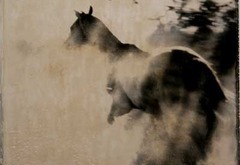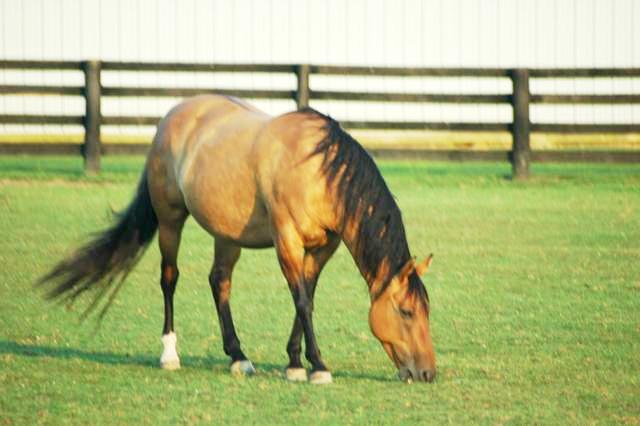 I had a reader contact me through my blog awhile back. She said that she and her family had acquired two yearling horses, and were having a little trouble getting them gentled down. When they were caught, they behaved pretty well, but catching them was a whole other story. I wrote her a personal email to answer her question, but I thought I could share some tips for working with a spooky horse here, in hopes of helping someone else.
I had a reader contact me through my blog awhile back. She said that she and her family had acquired two yearling horses, and were having a little trouble getting them gentled down. When they were caught, they behaved pretty well, but catching them was a whole other story. I wrote her a personal email to answer her question, but I thought I could share some tips for working with a spooky horse here, in hopes of helping someone else.
Let me share a story about a weanling horse of our own who was very apprehensive at being handled at first. Cowboy Dad and I went to one of those winter horse sales at a rundown auction barn and somehow had the winning bid on a little grade Appy colored weanling. He was a cute little silver colored stud colt with black spots over his hindquarters and fuzzy black and white striped mane. He looked like a skunk!
We had not brought our trailer to the sale, as we hadn’t planned on buying a horse at that time. So we made arrangements with the auction barn to keep him in a stall overnight and care for him until we could return. The next day, we returned with our trailer. It was a Sunday, and the barn was deserted. When we opened the back door of the stable part of the auction barn, the little guy started whinnying. He had probably been pretty lonely and traumatized in a new place all alone overnight.
We had bought a foal halter to fit him—he was tiny! And we hoped we could get it on him and then get him into the trailer. If he had been a bigger horse, it would have been a lot harder to accomplish, because he was so scared of us. I doubt if he had ever been handled, so he was like a little deer in that stall, just huddling in the corner and trembling in fear.
I went into the stall and had my husband stand at the door to discourage the colt from jumping. When I attempted to touch the colt, he would jump forward and run around me. Fortunately, the stall wasn’t very big, so I was able to work him into one corner up against the wall, with one hand in front of his chest, and the other one behind him. He was small enough that I was able to hold him in that position long enough to pass the leadrope over his neck. Then I grabbed it with the other hand, and I had him in a loop of rope. This made him even more afraid, and again he tried to run around me in a circle. But I held on until he stopped in a corner again, and then managed to reach the halter up and buckle it over his head.
After that, we didn’t have much trouble getting him into the trailer. He made the trip just fine, and was overjoyed when we arrived at our farm and he was introduced to Daisy, my older mare. It was love at first sight for both of them, and they are still very emotionally attached to this day. This colt, Milo, was not an overly spooky horse, but we could tell he had been neglected and not handled since birth. So it took a little grain to get him to change his mind about us. He has been gentle ever since.
Horses can be skittish as a result of abuse, which puts a permanent fear in their mind so that they are not comfortable around a human. But more often, it is the simple lack of handling that makes their natural instincts kick in and they try to avoid being touched. And this problem can be worked through. Wild deer can even be gentled if a person is patient enough to work with them. So unless a horse has been overly traumatized and hurt by a human, there’s a good chance they can be gentled.
Let me first suggest that you observe your horse before you start working with it. Try to discern what is motivating your horse to be skittish. If the horse is genuinely afraid of you, you may need to hire a professional horse trainer to help you. If cornered, a frightened horse can turn aggressive, and may strike or kick out at a person in order to defend itself. If you know your horse is avoiding you more because he doesn’t want to be ridden or worked, and is exhibiting behavior that is not dangerous to you, this may be something you can solve yourself.
Your best plan of action is to minimize the range of movement available to your horse. In other words, get him into a smaller pen. If the horse is extremely flighty and unused to human interaction, you might spend the first couple of days just standing next to the fence or in the middle of the pen and letting the horse get used to your presence. As the horse shows more ease and appears to be more relaxed with you just standing there, see if you can work your way closer to him, keeping your eyes lowered, a friendly hand extended, and your movements slow. Any exposure a frightened horse has to a slow-moving, low-speaking, friendly-appearing human will help him re-adjust his opinion of them in general. Horses are naturally curious, especially if they haven’t been handled much, and they will come nearer on their own if they start accepting you and learning not to fear you. So time and patience is the key, when working with a very frightened horse. Do not attempt to stop the horse from moving away from you, but a small pen will help him not to move very far. Your goal is to get the horse to decide for himself that moving away is just too much work and he needn’t bother because you aren’t that scary anyway.
As the horse gets more comfortable, you keep advancing your goals. At first, your goal might be to stand in the pen without the horse freaking out and running circles around you. Then, when you get to the point where he is just standing there too, or even eating or grazing in your presence, then you can move on to the next goal, which would be to be able to touch the horse. A horse is most easily approached from the side, at about his front shoulder. Never approach a spooky horse from the rear, and when you reach to pet a horse, always touch his shoulder or withers first. It’s an acceptable place for a horse to be touched (this is the favorite grooming spot of horses, when they stand neck to neck and nibble each other at the withers) and a spooky horse will not likely be as frightened if you touch his withers, as opposed to reaching for his face or hip.
When your touch is accepted without the horse moving away from you, then you can move on to your next goal, which is getting a halter on the horse. Start out petting the horse at the withers, then move forward and back, all around the horse, petting everywhere you can safely reach. When the horse accepts this readily, then introduce a simple lead rope with no halter attached. Use the rope like an extension of your hand, rub the horse all over with it, loop it over his back, around his neck, and move on up toward his face where the halter would fit. If at any time the horse pulls away and runs, let him move freely, and go back to your first goal and work through them again in sequence: get the horse to stop running from you, get the horse to let you touch it, touch it all over until you can get a halter on it. That is the best process for gentling a horse.
With an older horse that is just too ornery to let you catch him, and is avoiding being caught so he doesn’t have to be ridden and worked, you just modify your plan and skip ahead a few steps. Get him in a smaller pen if possible, separated from other horses. Don’t allow a horse to turn his heels at you and threaten to kick when you go to catch him. A threat of a kick deserves a well-placed lead rope whack on the hind end, while you be sure you keep yourself far back enough he can’t kick you. A lunge whip would be better for this, but if you don’t have one and you get threatened by your horse, do not just accept it and go on—make that horse move! You need to behave as a dominant horse would in this situation, and when threatened, you squelch it by striking back. If you don’t, your horse gets the upper hand and you lose all credibility as a leader.
To catch an ornery horse, sometimes it takes a handful of grain or a bucket. But don’t allow the horse to eat until he gets his halter on. Giving him grain and letting him run away from you again is just rewarding his bad behavior. Set a precedent with your horse and reward him when he does the desired action. The same principles of working with a frightened horse apply, but you can be much more assertive with a trained horse who is just being ornery. So work to get the halter on, but don’t tolerate bad behavior such as turning his rear end toward you and threatening to kick. A trained horse should be taught to face you, and this can be done by swinging the lead rope at his hind end every time he turns it to you. When he turns to face you, instantly lower the rope, talk sweet talk in a nice tone, and offer him a handful of grain if he will let you put his halter on. This isn’t suggested for a frightened horse, because it will only heighten his anxiety. But it will make a trained horse learn to face you and come to you to be caught.
These are just a few ideas to help you work through the first steps of gentling and training your horse. If you have any questions or further suggestions, feel free to post a comment or email me. Good luck!


{ 1 comment }
I wish I had read this a month ago! It took me two hours to catch my horse the first time in her paddock! Then, I discovered grain and now I am able to catch her without grain, all in the span of a month. She came from an abusive past and I have been working hard on gaining trust and developing her (and my) confidence.
http://www.adventureswithahorse.blogspot.com